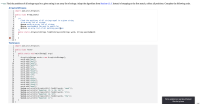
Database System Concepts
7th Edition
ISBN: 9780078022159
Author: Abraham Silberschatz Professor, Henry F. Korth, S. Sudarshan
Publisher: McGraw-Hill Education
expand_more
expand_more
format_list_bulleted
Question
Find the positions of all strings equal to a given string in an array list of strings. Adapt the
/**
Finds the positions of all strings equal to a given string
in an array list of strings.
@param words an array list of strings
@param searchedWord the word to search for
@return an array list of all matching positions
*/

Expert Solution
This question has been solved!
Explore an expertly crafted, step-by-step solution for a thorough understanding of key concepts.
This is a popular solution
Trending nowThis is a popular solution!
Step by stepSolved in 3 steps with 3 images

Knowledge Booster
Learn more about
Need a deep-dive on the concept behind this application? Look no further. Learn more about this topic, computer-science and related others by exploring similar questions and additional content below.Similar questions
- An element that comprises more than half of the items in an array is referred to as a majority element. Find the dominant element in a list of positive integers. Return -1 if there is no majority element. Execute this in 0(1) space and O(N) time.Input: 1 2 5 9 5 9 5 5 55 outputAn element that comprises more than half of the items in an array is referred to as a majority element. Find the dominant element in a list of positive integers. Return -1 if there is no majority element. Execute this in 0(1) space and O(N) time.Input: 1 2 5 9 5 9 5 5 55 outputarrow_forwardx = zeros(5,5)for i = 1:1:5for j = 1:1:5x(i,j) = i*j;endendWhich of the following best describes the variable i? 1. An array of length 5 2. A constant value in the equation i*j 3. A counting variable that indexes columns 4. A counting variable that indexes rowsarrow_forward%matplotlib inline import math import numpy as np from matplotlib import pyplot as plt def f(x): return math.sqrt(-x/(x+1)) def g(x): return math.tan(math.sqrt(2*(x + 1))) xs = np.linspace(-0.999,-0.1, 100) fx = [f(x) for x in xs] gx = [g(x) for x in xs] plt.plot(xs,fx) plt.plot(xs,gx) plt.gridarrow_forward
- Complete the below function (using recursion)arrow_forwardSearches the specified array of objects using a linear search * algorithm. * * @param data the array to be searched * @param min the integer representation of the minimum value * @param max the integer representation of the maximum value * @param target the element being searched for * @return true if the desired element is found use java to codearrow_forwardComplete the combinations function to generate all combinations of the characters in the string s with length k recursivelyarrow_forward
- Using HTML and JavaScript do the following: Implement Insertion Sort 1. Non-increasing order, 2. At least an array of 10 elements., 3. You can use a static array.arrow_forwarddo not plagiarisearrow_forwardWrite a program that does the following: 1. prompts the user to guess a letter in a hard-coded word 2. validates the input 3. adds the letter to a two-dimensional array that stores the guessed letter (string) and the number of times that letter has been guessed (int). If the letter is already in the list, then the list should be updated accordingly (i.e., no duplicate letters in the list!) The list will follow this format: [[guessed letter 1, number of guesses],[guessed letter2, number of guesses],...] Example: [[“a”, 3], [“e”, 2], [“c”, 1]] Hint : this will require iterating over the list, remember that the character is always in position [x][0] 4. check if the character is in the word 5. outputs if the character is in the word and the number of times this character has been guessed 6. the program should continue to prompt the user until they enter ‘quit’ Output example: #the word is kookaburra Enter a letter: a The letter ‘a’ is in the word Number of times guessed the letter…arrow_forward
arrow_back_ios
arrow_forward_ios
Recommended textbooks for you
 Database System ConceptsComputer ScienceISBN:9780078022159Author:Abraham Silberschatz Professor, Henry F. Korth, S. SudarshanPublisher:McGraw-Hill Education
Database System ConceptsComputer ScienceISBN:9780078022159Author:Abraham Silberschatz Professor, Henry F. Korth, S. SudarshanPublisher:McGraw-Hill Education Starting Out with Python (4th Edition)Computer ScienceISBN:9780134444321Author:Tony GaddisPublisher:PEARSON
Starting Out with Python (4th Edition)Computer ScienceISBN:9780134444321Author:Tony GaddisPublisher:PEARSON Digital Fundamentals (11th Edition)Computer ScienceISBN:9780132737968Author:Thomas L. FloydPublisher:PEARSON
Digital Fundamentals (11th Edition)Computer ScienceISBN:9780132737968Author:Thomas L. FloydPublisher:PEARSON C How to Program (8th Edition)Computer ScienceISBN:9780133976892Author:Paul J. Deitel, Harvey DeitelPublisher:PEARSON
C How to Program (8th Edition)Computer ScienceISBN:9780133976892Author:Paul J. Deitel, Harvey DeitelPublisher:PEARSON Database Systems: Design, Implementation, & Manag...Computer ScienceISBN:9781337627900Author:Carlos Coronel, Steven MorrisPublisher:Cengage Learning
Database Systems: Design, Implementation, & Manag...Computer ScienceISBN:9781337627900Author:Carlos Coronel, Steven MorrisPublisher:Cengage Learning Programmable Logic ControllersComputer ScienceISBN:9780073373843Author:Frank D. PetruzellaPublisher:McGraw-Hill Education
Programmable Logic ControllersComputer ScienceISBN:9780073373843Author:Frank D. PetruzellaPublisher:McGraw-Hill Education

Database System Concepts
Computer Science
ISBN:9780078022159
Author:Abraham Silberschatz Professor, Henry F. Korth, S. Sudarshan
Publisher:McGraw-Hill Education

Starting Out with Python (4th Edition)
Computer Science
ISBN:9780134444321
Author:Tony Gaddis
Publisher:PEARSON

Digital Fundamentals (11th Edition)
Computer Science
ISBN:9780132737968
Author:Thomas L. Floyd
Publisher:PEARSON

C How to Program (8th Edition)
Computer Science
ISBN:9780133976892
Author:Paul J. Deitel, Harvey Deitel
Publisher:PEARSON

Database Systems: Design, Implementation, & Manag...
Computer Science
ISBN:9781337627900
Author:Carlos Coronel, Steven Morris
Publisher:Cengage Learning

Programmable Logic Controllers
Computer Science
ISBN:9780073373843
Author:Frank D. Petruzella
Publisher:McGraw-Hill Education